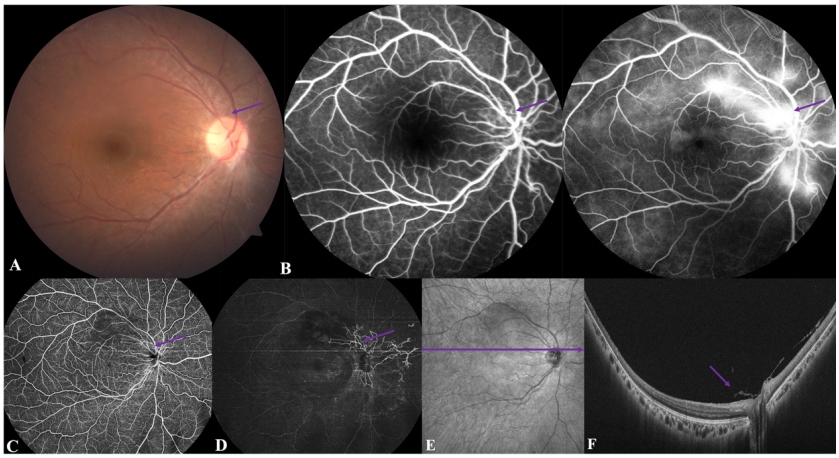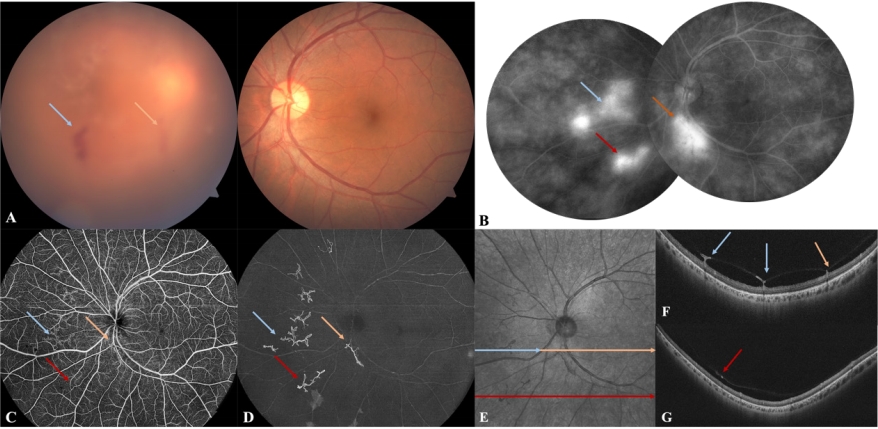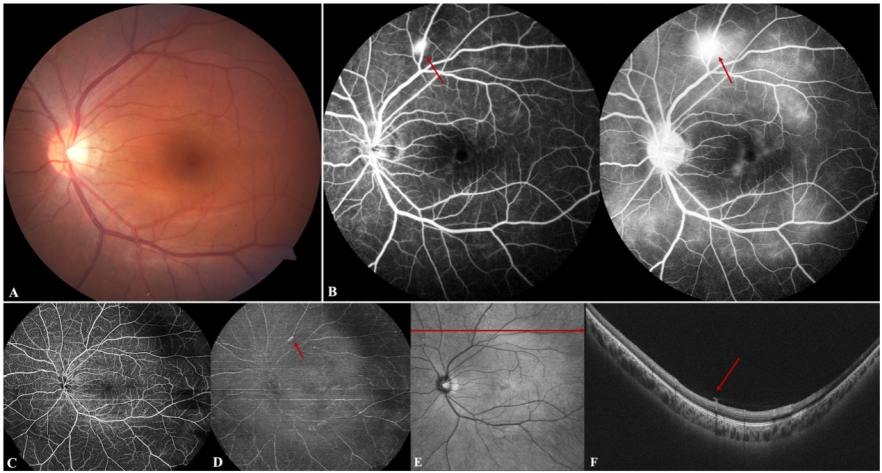1、Deuter%20C%2C%20Kotter%20I%2C%20Wallace%20G%2C%20et%20al.%20Beh%C3%A7et's%20disease%3A%20Ocular%20effects%20%0Aand%20treatment%5B%20J%5D.%20Prog%20Retin%20Eye%20Res%2C%202008%2C%2027(1)%3A%20111-136.%20DOI%3A%20%0A10.1016%2Fj.preteyeres.2007.09.002.Deuter%20C%2C%20Kotter%20I%2C%20Wallace%20G%2C%20et%20al.%20Beh%C3%A7et's%20disease%3A%20Ocular%20effects%20%0Aand%20treatment%5B%20J%5D.%20Prog%20Retin%20Eye%20Res%2C%202008%2C%2027(1)%3A%20111-136.%20DOI%3A%20%0A10.1016%2Fj.preteyeres.2007.09.002.
2、Maldini%20C%2C%20Druce%20K%2C%20Basu%20N%2C%20et%20al.%20Exploring%20the%20variability%20in%20beh%C3%A7et's%20%0Adisease%20prevalence%3A%20a%20meta-analytical%20approach%5B%20J%5D.%20Rheumatology%2C%20%0A2018%2C%2057(1)%3A%20185-195.%20DOI%3A10.1093%2Frheumatology%2Fkew486.Maldini%20C%2C%20Druce%20K%2C%20Basu%20N%2C%20et%20al.%20Exploring%20the%20variability%20in%20beh%C3%A7et's%20%0Adisease%20prevalence%3A%20a%20meta-analytical%20approach%5B%20J%5D.%20Rheumatology%2C%20%0A2018%2C%2057(1)%3A%20185-195.%20DOI%3A10.1093%2Frheumatology%2Fkew486.
3、Yang%20P%2C%20Fang%20W%2C%20Meng%20Q%2C%20et%20al.%20Clinical%20features%20of%20Chinese%20patients%20%0Awith%20Beh%C3%A7et's%20disease%5B%20J%5D.%20Ophthalmology%2C%202008%2C%20115(2)%3A%20312-318.e4.%20%0ADOI%3A10.1016%2Fj.ophtha.2007.04.056.Yang%20P%2C%20Fang%20W%2C%20Meng%20Q%2C%20et%20al.%20Clinical%20features%20of%20Chinese%20patients%20%0Awith%20Beh%C3%A7et's%20disease%5B%20J%5D.%20Ophthalmology%2C%202008%2C%20115(2)%3A%20312-318.e4.%20%0ADOI%3A10.1016%2Fj.ophtha.2007.04.056.
4、Yang P, Zhong Z, Du L, et al. Prevalence and clinical features of
systemic diseases in Chinese patients with uveitis[ J]. Br J Ophthalmol,
2021, 105(1): 75-82. DOI:10.1136/bjophthalmol-2020-315960.Yang P, Zhong Z, Du L, et al. Prevalence and clinical features of
systemic diseases in Chinese patients with uveitis[ J]. Br J Ophthalmol,
2021, 105(1): 75-82. DOI:10.1136/bjophthalmol-2020-315960.
5、Atmaca%20LS%2C%20Batio%C4%9Flu%20F%2C%20Idil%20A.%20Retinal%20and%20disc%20neovascularization%20in%20%0ABeh%C3%A7et's%20disease%20and%20efficacy%20of%20laser%20photocoagulation%5B%20J%5D.%20Graefes%20%0AArch%20Clin%20Exp%20Ophthalmol%2C%201996%2C%20234(2)%3A%2094-99.%20DOI%3A10.1007%2F%0ABF00695247.Atmaca%20LS%2C%20Batio%C4%9Flu%20F%2C%20Idil%20A.%20Retinal%20and%20disc%20neovascularization%20in%20%0ABeh%C3%A7et's%20disease%20and%20efficacy%20of%20laser%20photocoagulation%5B%20J%5D.%20Graefes%20%0AArch%20Clin%20Exp%20Ophthalmol%2C%201996%2C%20234(2)%3A%2094-99.%20DOI%3A10.1007%2F%0ABF00695247.
6、Tugal-Tutkun%20I%2C%20Onal%20S%2C%20Altan-Yaycioglu%20R%2C%20et%20al.%20Uveitis%20in%20Beh%C3%A7et%20%0Adisease%3A%20an%20analysis%20of%20880%20patients%5B%20J%5D.%20Am%20J%20Ophthalmol%2C%202004%2C%20%0A138(3)%3A%20373-380.%20DOI%3A10.1016%2Fj.ajo.2004.03.022.Tugal-Tutkun%20I%2C%20Onal%20S%2C%20Altan-Yaycioglu%20R%2C%20et%20al.%20Uveitis%20in%20Beh%C3%A7et%20%0Adisease%3A%20an%20analysis%20of%20880%20patients%5B%20J%5D.%20Am%20J%20Ophthalmol%2C%202004%2C%20%0A138(3)%3A%20373-380.%20DOI%3A10.1016%2Fj.ajo.2004.03.022.
7、Tugal-Tutkun%20I%2C%20Onal%20S%2C%20Altan-Yaycioglu%20R%2C%20et%20al.%20Neovascularization%20of%20%0Athe%20optic%20disc%20in%20beh%C3%A7et's%20disease%5B%20J%5D.%20Jpn%20J%20Ophthalmol%2C%202006%2C%2050(3)%3A%20%0A256-265.%20DOI%3A10.1007%2Fs10384-005-0307-8.Tugal-Tutkun%20I%2C%20Onal%20S%2C%20Altan-Yaycioglu%20R%2C%20et%20al.%20Neovascularization%20of%20%0Athe%20optic%20disc%20in%20beh%C3%A7et's%20disease%5B%20J%5D.%20Jpn%20J%20Ophthalmol%2C%202006%2C%2050(3)%3A%20%0A256-265.%20DOI%3A10.1007%2Fs10384-005-0307-8.
8、Henkind P. Ocular neovascularization[ J]. Am J Ophthalmol, 1978,
85(3): 287-301. DOI:10.1016/s0002-9394(14)77719-0.Henkind P. Ocular neovascularization[ J]. Am J Ophthalmol, 1978,
85(3): 287-301. DOI:10.1016/s0002-9394(14)77719-0.
9、Jansson%20RW%2C%20Fr%C3%B8ystein%20T%2C%20Krohn%20J.%20Topographical%20distribution%20of%20retinal%20%0Aand%20optic%20disc%20neovascularization%20in%20early%20stages%20of%20proliferative%20diabetic%20%0Aretinopathy%5B%20J%5D.%20Invest%20Ophthalmol%20Vis%20Sci%2C%202012%2C%2053(13)%3A%208246-8252.%20%0ADOI%3A10.1167%2Fiovs.12-10918.Jansson%20RW%2C%20Fr%C3%B8ystein%20T%2C%20Krohn%20J.%20Topographical%20distribution%20of%20retinal%20%0Aand%20optic%20disc%20neovascularization%20in%20early%20stages%20of%20proliferative%20diabetic%20%0Aretinopathy%5B%20J%5D.%20Invest%20Ophthalmol%20Vis%20Sci%2C%202012%2C%2053(13)%3A%208246-8252.%20%0ADOI%3A10.1167%2Fiovs.12-10918.
10、Sambhav K, Grover S, Chalam KV. The application of optical coherence
tomography angiography in retinal diseases[ J]. Surv Ophthalmol,
2017, 62(6): 838-866. DOI:10.1016/j.survophthal.2017.05.006.Sambhav K, Grover S, Chalam KV. The application of optical coherence
tomography angiography in retinal diseases[ J]. Surv Ophthalmol,
2017, 62(6): 838-866. DOI:10.1016/j.survophthal.2017.05.006.
11、International%20Study%20Group%20for%20Beh%C3%A7et's%20Disease.%20Criteria%20for%20diagnosis%20%0Aof%20Beh%C3%A7et's%20disease%5B%20J%5D.%20Lancet%20(London%2C%20England)%2C%201990%2C%20335(8697)%3A%20%0A1078-1080.International%20Study%20Group%20for%20Beh%C3%A7et's%20Disease.%20Criteria%20for%20diagnosis%20%0Aof%20Beh%C3%A7et's%20disease%5B%20J%5D.%20Lancet%20(London%2C%20England)%2C%201990%2C%20335(8697)%3A%20%0A1078-1080.
12、Tugal-Tutkun I, Herbort CP, Khairallah M, et al. Scoring of dual
fluorescein and ICG inflammatory angiographic signs for the grading
of posterior segment inflammation (dual fluorescein and ICG
angiographic scoring system for uveitis)[ J]. Int Ophthalmol, 2010,
30(5): 539-552. DOI:10.1007/s10792-008-9263-x.Tugal-Tutkun I, Herbort CP, Khairallah M, et al. Scoring of dual
fluorescein and ICG inflammatory angiographic signs for the grading
of posterior segment inflammation (dual fluorescein and ICG
angiographic scoring system for uveitis)[ J]. Int Ophthalmol, 2010,
30(5): 539-552. DOI:10.1007/s10792-008-9263-x.
13、International%20Team%20for%20the%20Revision%20of%20the%20International%20Criteria%20for%20%0ABeh%C3%A7et's%20Disease%20(ITR-ICBD).%20The%20international%20criteria%20for%20beh%C3%A7et's%20%0Adisease%20(ICBD)%3A%20a%20collaborative%20study%20of%2027%20countries%20on%20the%20sensitivity%20%0Aand%20specificity%20of%20the%20new%20criteria%5B%20J%5D.%20J%20Eur%20Acad%20Dermatol%20Venereol%2C%20%0A2014%2C%2028(3)%3A%20338-347.%20DOI%3A10.1111%2Fjdv.12107.International%20Team%20for%20the%20Revision%20of%20the%20International%20Criteria%20for%20%0ABeh%C3%A7et's%20Disease%20(ITR-ICBD).%20The%20international%20criteria%20for%20beh%C3%A7et's%20%0Adisease%20(ICBD)%3A%20a%20collaborative%20study%20of%2027%20countries%20on%20the%20sensitivity%20%0Aand%20specificity%20of%20the%20new%20criteria%5B%20J%5D.%20J%20Eur%20Acad%20Dermatol%20Venereol%2C%20%0A2014%2C%2028(3)%3A%20338-347.%20DOI%3A10.1111%2Fjdv.12107.
14、Keino%20H.%20Evaluation%20of%20disease%20activity%20in%20uveoretinitis%20associated%20with%20%0ABeh%C3%A7et's%20disease%5B%20J%5D.%20Immunol%20Med%2C%202021%2C%2044(2)%3A%2086-97.%20DOI%3A10.1080%2F%0A25785826.2020.1800244.Keino%20H.%20Evaluation%20of%20disease%20activity%20in%20uveoretinitis%20associated%20with%20%0ABeh%C3%A7et's%20disease%5B%20J%5D.%20Immunol%20Med%2C%202021%2C%2044(2)%3A%2086-97.%20DOI%3A10.1080%2F%0A25785826.2020.1800244.
15、Suzuki K, Iwata D, Namba K, et al. Involvement of Angiopoietin 2
and vascular endothelial growth factor in uveitis[ J]. PLoS One, 2023,
18(11): e0294745. DOI:10.1371/journal.pone.0294745.Suzuki K, Iwata D, Namba K, et al. Involvement of Angiopoietin 2
and vascular endothelial growth factor in uveitis[ J]. PLoS One, 2023,
18(11): e0294745. DOI:10.1371/journal.pone.0294745.
16、Gross JG, Glassman AR, Liu D, et al. Five-year outcomes of panretinal
photocoagulation vs intravitreous ranibizumab for proliferative diabetic
retinopathy: a randomized clinical trial[ J]. JAMA Ophthalmol, 2018,
136(10): 1138-1148. DOI:10.1001/jamaophthalmol.2018.3255.Gross JG, Glassman AR, Liu D, et al. Five-year outcomes of panretinal
photocoagulation vs intravitreous ranibizumab for proliferative diabetic
retinopathy: a randomized clinical trial[ J]. JAMA Ophthalmol, 2018,
136(10): 1138-1148. DOI:10.1001/jamaophthalmol.2018.3255.
17、Rogers SL, McIntosh RL, Lim L, et al. Natural history of branch
retinal vein occlusion: an evidence-based systematic review[ J].
Ophthalmology, 2010, 117(6): 1094-1101.e5. DOI:10.1016/
j.ophtha.2010.01.058.Rogers SL, McIntosh RL, Lim L, et al. Natural history of branch
retinal vein occlusion: an evidence-based systematic review[ J].
Ophthalmology, 2010, 117(6): 1094-1101.e5. DOI:10.1016/
j.ophtha.2010.01.058.
18、McIntosh RL, Rogers SL, Lim L, et al. Natural history of central
retinal vein occlusion: an evidence-based systematic review[ J].
Ophthalmology, 2010, 117(6): 1113-1123.e15. DOI:10.1016/
j.ophtha.2010.01.060.McIntosh RL, Rogers SL, Lim L, et al. Natural history of central
retinal vein occlusion: an evidence-based systematic review[ J].
Ophthalmology, 2010, 117(6): 1113-1123.e15. DOI:10.1016/
j.ophtha.2010.01.060.
19、Zhong%20Z%2C%20Su%20G%2C%20Yang%20P.%20Risk%20factors%2C%20clinical%20features%20and%20treatment%20%0Aof%20Beh%C3%A7et's%20disease%20uveitis%5B%20J%5D.%20Prog%20Retin%20Eye%20Res%2C%202023%2C%2097%3A%20101216.%20%0ADOI%3A10.1016%2Fj.preteyeres.2023.101216.Zhong%20Z%2C%20Su%20G%2C%20Yang%20P.%20Risk%20factors%2C%20clinical%20features%20and%20treatment%20%0Aof%20Beh%C3%A7et's%20disease%20uveitis%5B%20J%5D.%20Prog%20Retin%20Eye%20Res%2C%202023%2C%2097%3A%20101216.%20%0ADOI%3A10.1016%2Fj.preteyeres.2023.101216.
20、Sanislo SR , Lowder CY, Kaiser PK, et al. Corticosteroid therapy
for optic disc neovascularization secondary to chronic uveitis[ J].
Am J Ophthalmol, 2000, 130(6): 724-731. DOI:10.1016/s0002-
9394(00)00598-5.Sanislo SR , Lowder CY, Kaiser PK, et al. Corticosteroid therapy
for optic disc neovascularization secondary to chronic uveitis[ J].
Am J Ophthalmol, 2000, 130(6): 724-731. DOI:10.1016/s0002-
9394(00)00598-5.
21、Zaguia F, Marchese A, Cicinelli MV, et al. Long-term success treating
inflammatory epiretinal neovascularization with immunomodulatory
therapy[ J]. Graefes Arch Clin Exp Ophthalmol, 2022, 260(2): 553-
559. DOI:10.1007/s00417-021-05396-6.Zaguia F, Marchese A, Cicinelli MV, et al. Long-term success treating
inflammatory epiretinal neovascularization with immunomodulatory
therapy[ J]. Graefes Arch Clin Exp Ophthalmol, 2022, 260(2): 553-
559. DOI:10.1007/s00417-021-05396-6.
22、Amin RH, Frank RN, Kennedy A, et al. Vascular endothelial growth
factor is present in glial cells of the retina and optic nerve of human
subjects with nonproliferative diabetic retinopathy[ J]. Invest
Ophthalmol Vis Sci, 1997,38(1):36-47.Amin RH, Frank RN, Kennedy A, et al. Vascular endothelial growth
factor is present in glial cells of the retina and optic nerve of human
subjects with nonproliferative diabetic retinopathy[ J]. Invest
Ophthalmol Vis Sci, 1997,38(1):36-47.
23、Santos-Bueso%20E%2C%20Asorey-Garc%C3%ADa%20A%2C%20Ruiz-Medrano%20J%2C%20et%20al.%20Canal%20de%20%0Acloquet%20o%20conducto%20de%20stilling%20y%20espacio%20de%20martegiani%5B%20J%5D.%20Arch%20De%20%0ALa%20Soc%20Espa%C3%B1ola%20De%20Oftalmol%2C%202015%2C%2090(7)%3A%20350-351.%20DOI%3A10.1016%2F%0Aj.oftal.2014.04.010.Santos-Bueso%20E%2C%20Asorey-Garc%C3%ADa%20A%2C%20Ruiz-Medrano%20J%2C%20et%20al.%20Canal%20de%20%0Acloquet%20o%20conducto%20de%20stilling%20y%20espacio%20de%20martegiani%5B%20J%5D.%20Arch%20De%20%0ALa%20Soc%20Espa%C3%B1ola%20De%20Oftalmol%2C%202015%2C%2090(7)%3A%20350-351.%20DOI%3A10.1016%2F%0Aj.oftal.2014.04.010.
24、Ishibazawa A, Nagaoka T, Yokota H, et al. Characteristics of retinal
neovascularization in proliferative diabetic retinopathy imaged by
optical coherence tomography angiography[ J]. Invest Ophthalmol Vis
Sci, 2016, 57(14): 6247-6255. DOI:10.1167/iovs.16-20210.Ishibazawa A, Nagaoka T, Yokota H, et al. Characteristics of retinal
neovascularization in proliferative diabetic retinopathy imaged by
optical coherence tomography angiography[ J]. Invest Ophthalmol Vis
Sci, 2016, 57(14): 6247-6255. DOI:10.1167/iovs.16-20210.
25、Zeng%20Y%2C%20Zhang%20X%2C%20Mi%20L%2C%20et%20al.%20Macrophage-like%20cells%20characterized%20by%20%0Aen%20face%20optical%20coherence%20tomography%20was%20associated%20with%20fluorescein%20%0Avascular%20leakage%20in%20beh%C3%A7et's%20uveitis%5B%20J%5D.%20Ocul%20Immunol%20Inflamm%2C%202023%2C%20%0A31(5)%3A%20999-1005.%20DOI%3A10.1080%2F09273948.2022.2080719.Zeng%20Y%2C%20Zhang%20X%2C%20Mi%20L%2C%20et%20al.%20Macrophage-like%20cells%20characterized%20by%20%0Aen%20face%20optical%20coherence%20tomography%20was%20associated%20with%20fluorescein%20%0Avascular%20leakage%20in%20beh%C3%A7et's%20uveitis%5B%20J%5D.%20Ocul%20Immunol%20Inflamm%2C%202023%2C%20%0A31(5)%3A%20999-1005.%20DOI%3A10.1080%2F09273948.2022.2080719.
26、Guo S, Liu H, Gao Y, et al. Analysis of vascular changes of fundus in
behcet uveitis by widefield swept source optical coherence tomography
angiography and fundus fluorescein angiography[ J]. Retina, 2023,
43(5): 841-850. DOI:10.1097/IAE.0000000000003709.Guo S, Liu H, Gao Y, et al. Analysis of vascular changes of fundus in
behcet uveitis by widefield swept source optical coherence tomography
angiography and fundus fluorescein angiography[ J]. Retina, 2023,
43(5): 841-850. DOI:10.1097/IAE.0000000000003709.
27、Dai L, Huang F, Jiang Q, et al. Sensitive optical coherence tomography
angiography parameters detecting retinal vascular changes in Behcet's
uveitis[ J]. Photodiagnosis Photodyn Ther, 2024, 49: 104353.
DOI:10.1016/j.pdpdt.2024.104353.Dai L, Huang F, Jiang Q, et al. Sensitive optical coherence tomography
angiography parameters detecting retinal vascular changes in Behcet's
uveitis[ J]. Photodiagnosis Photodyn Ther, 2024, 49: 104353.
DOI:10.1016/j.pdpdt.2024.104353.







